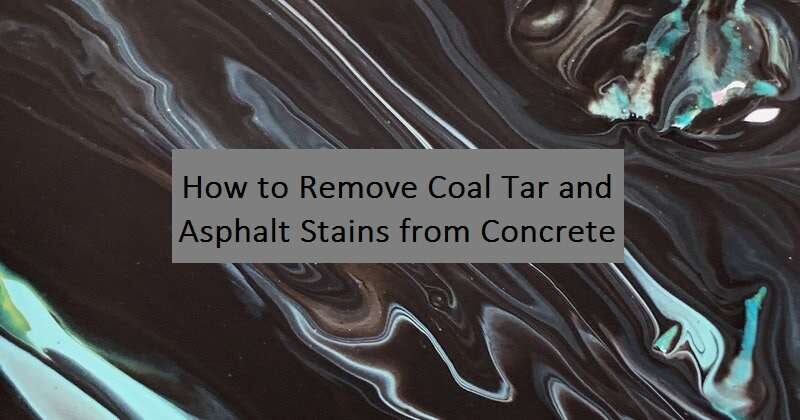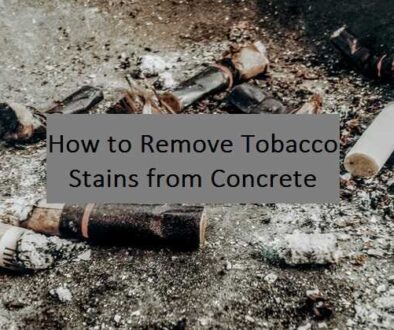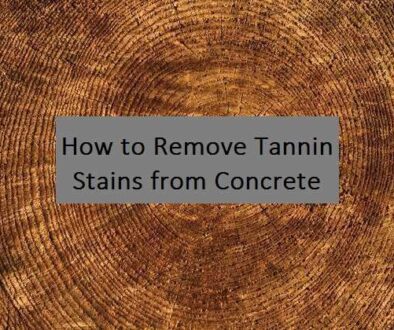How to Remove Coal Tar and Asphalt Stains from Concrete

Last updated on December 20th, 2022
Coal tar and asphalt stains can be one of the toughest stains to remove from concrete due to their good bond. This is especially true for old bitumen that have penetrated deep into the surface. But some bitumen stains can be easier to remove than others, depending on their form. Accordingly, this article addresses different removal methods for different forms of bitumen stains, including molten, emulsified, and cutback.
The most effective removal methods
Molten, emulsified, and cutback bitumen stains on concrete generally have different toughness and require different removal methods. In fact, some can be easy to completely clean off, while others can be almost impossible.
How to remove mild coal tar and molten asphalt stains from concrete

Molten asphalt does not usually penetrate deep into concrete, and thereby is relatively easy to remove.
Things you will need
- Gloves.
- Ice.
- Chisel.
- Scouring powder.
- Stiff bristle brush.
- Water.
Notes
- Scouring powder or abrasive powder.
Appearance: Usually white powder, but can come in different colors.
Availability: It available at the supermarkets and cleaning supply stores.
Hazards: Can be corrosive to flesh.
Procedure
- Put on your safety gloves.
- Place normal ice to cool the molten asphalt until it becomes brittle.
- Chip off the brittle asphalt using a chisel.
- Scrub the surface with scouring powder and water using a stiff bristle brush.
- Rinse and flush the surface.
- Repeat if necessary.
Explanation
Since molten asphalt does not penetrate deep into the surface of concrete, all it requires is some elbow grease to remove. However, it can be sticky to remove in its original form, especially in hot weather. Thereby, the first step is to cool down the molten asphalt as much as possible to become brittle and easier to remove. Accordingly, you can apply normal ice right to the stains for a few minutes.
Then, use a chisel to chip off the brittle asphalt, and repeat the cooling down process with ice if necessary. Next, scrape off and scrub the remains using scouring powder and cold water. In fact, it is important to keep the asphalt and its remains cool and brittle in order to simplify their removal. And finally, rinse the surface thoroughly with clean water.
How to remove moderately stubborn coal tar and emulsified asphalt stains from concrete

An asphalt emulsion, which is a dispersion of bitumen droplets in water, is also relatively easy to remove from concrete. In fact, this material does not usually penetrate deep, which simplifies its removal. However, it is important not to use inadequate cleaning methods, such as the application of solvents even in the form of a poultice, as this will push the stain deeper and make it almost impossible to remove completely.
Things you will need
- Gloves.
- Scouring or abrasive powder.
- Stiff bristle brush.
- Water.
Procedure
- Scrub the stains with scouring powder and water using a stiff bristle brush.
- Rinse thoroughly.
- Repeat if necessary.
Explanation
The ideal removal method of asphalt emulsion from a concrete surface usually requires only some scrubbing with an abrasive powder. This is mainly because this material does not penetrate the surface, and thus its removal requires some mechanical action to loosen up the film.
It is important to note that the use of any solvents or solvent-impregnated poultices or bandages is not recommended, as this can push down the bitumen further into the pores of concrete.
How to remove stubborn coal tar and cutback asphalt stains from concrete

Cutback asphalt, which is a solution of bitumen and solvent, can easily penetrate deep into the surface, and is the toughest among all asphalt stains. Accordingly, it is usually impossible to completely remove. However, we will present a method which can significantly reduce the stain through the application of a poultice.
Things you will need
- Safety gear.
- Kerosene / carbon tetrachloride / toluene / benzol.
- Talc / calcium carbonate (whiting).
- Stiff bristle brush.
- Scouring powder.
- Water.
Notes
- Kerosene: Also known as Paraffin Oil or Lamp Oil.
Appearance: Colorless or slightly yellowish liquid.
Availability: It is available at hardware stores and gas stations.
Hazards: Toxic, flammable. - Carbon Tetrachloride: Other names include Perchloromethane and tetrachloromethane.
Appearance: Clear colorless liquid.
Availability: It is available at pharmacies, cleaning supply centers, and paint stores.
Hazards: Toxic, carcinogenic - Toluene: Other names include Methylbenzene or Phenylmethane.
Appearance: Clear liquid.
Availability: It is available at chemical, hardware, and paint stores.
Hazards: This compound is flammable and toxic. - Benzene: Other names include Benzol or Coal Naphtha.
Appearance: Colorless liquid.
Availability: It is available at chemical, hardware, and paint stores.
Hazards: This compound is highly flammable, toxic, and carcinogenic.
Procedure
- Wear your protective gear.
- Prepare a poultice by mixing kerosene / carbon tetrachloride / toluene / benzene with talc or calcium carbonate, and apply to the cutback asphalt stain.
- After the poultice dries, scrape off the remains.
- Scrub with scouring powder using a stiff bristle brush.
- Rinse and flush with clean water.
- Repeat if necessary until you can achieve no further improvement.
Explanation
The ideal method for the removal of cutback asphalt stains involves the application of a poultice. First, put on your safety gear, and work in area with a good ventilation. Then, mix kerosene, carbon tetrachloride, toluene, or benzene with talc to form a thick paste, and apply to the stains. Mainly, this poultice should be about 1/2 an inch (~13 mm) in thickness, exceeding the margins of the stains. In fact, this poultice can help in breaking down and absorbing some of the bitumen. Then, after the poultice dries, scrape off its remains, and scrub with scouring powder using a stiff bristle brush. And finally, rinse thoroughly and flush the surface with clean water.
It is important to note that stubborn cutback asphalt stains on concrete surfaces are basically impossible to completely remove. In general, you can significantly reduce the stain and remove the surface film with this method. However, more aggressive mechanical methods can be highly effective, but will alter the appearance and texture of the surface.
The use of special tar removers

Asphalt and tar removers for concrete are special products which are mostly multi-purpose solvent cleaners. They can be highly effective for mild and moderately stubborn tar stains, and are often easy to use. Besides, there are various products in the market, and can have different application methods. However, we will briefly address the typical method, but recommend to follow the manufacturer’s instructions depending on the specific product in use.
Things you will need
- Safety gear.
- Asphalt and tar remover products.
- Brush / sprayer / piece of cloth.
- Stiff bristle brush / broom.
- Clean water.
Procedure
- Wear your safety gear.
- Apply the asphalt and tar remover to the stain using a brush or sprayer.
- Allow the product to sit for a certain period of time (dwell time), depending on the product.
- Scrub the tar stains using a bristle brush.
- Flush the surface with clean water.
Explanation
Most of the tar removers consist of a proprietary composition, but generally contain solvents, which are similar to the ones we previously addressed in other methods. Thereby, it is important to protect yourself and the surroundings from hazards or damage. Accordingly, you should always follow the product’s instructions and comply with its safety data sheet.
In general, most of the tar removers require direct application of the product to the stain, and allowing it to sit for a few minutes. During this time, the chemicals help in breaking down and loosening up the stain. Then, you should scrub the surface using a stiff bristle brush or broom, and finish with flushing the surface, or pressure washing it.




